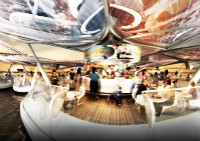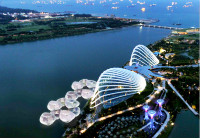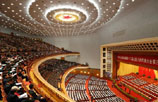SPARK Launches "Waterscape Dining" Concept with Global Potential
(chinadaily.com.cn) Updated: 2014-08-22 11:35International architectural design-consulting firm SPARK recently released its concept for a solar-powered floating restaurant titled "Solar Orchid". It was designed in response to the Singapore context, but has the potential for installation in protected waterways anywhere in the world. Given the historic connections between Singapore and China, which persist in everyday customs including cuisine, China would be an important stop for the “Solar Orchid”.
The "Solar Orchid" was designed to comply with developments in sustainable technology and architecture. It integrates elements of traditional hawker centre design with a futuristic style, and makes use of the latest sustainable technology. It embraces and supports local cultural traditions and provides a place for dining and socialising in a fun and unique way. The design concept could offer major significance for the construction and development of large and medium-sized hydrophilic cities.
Re-engaging with the water in Singapore
Singapore was built on an intimate relationship with the water, which has historically been an artery of culture, commerce and recreation. However, the recent decades of urban development, industrialisation and land reclamation have largely severed this relationship, deleting most of the traditional buildings from the coast, inland water bodies and sea. SPARK's "Solar Orchid" concept recalls the life experience of living close to the water, and embraces the tradition of dining at hawker centres. The “Solar Orchid” is essentially a floating hawker centre – a self-contained, sustainable and solar-powered pod that recalls the mobility of Singapore’s first street hawkers.
Each pod accommodates cooking stalls (incorporating built-in exhaust, water, gas, electrical, waste collection and water recycling services) as well as table settings. The protective leaf-like canopy incorporates thin-film photovoltaic cells to capture solar energy.


As good as water – sustainable buildings for the enjoyment of life
In busy and congested Chinese cities, more and more young professionals are seeking relaxation through refreshing lifestyle pursuits. A building or structure that offers a direct connection with the natural environment can inspire the senses, while also providing an enjoyable social space.
The "Solar Orchid" concept offers a variety of cluster formations. It is equipped with new environmentally friendly materials, and its integration with the waterscape presents new siting opportunities in the city. It has the possibility of reconnecting city dwellers with waterscapes that may have been forgotten or overlooked, and revitalising parts of the city with recreational activities that recall traditional lifestyles. Its mobility can enhance the flexibility and excitement of urban life. Furthermore, the "Solar Orchid" concept sits comfortably beside existing solar energy developments and concepts in China.


As described by SPARK Director Stephen Pimbley, "This independently initiated concept presents a new energy-saving design, and has received a very good response in Singapore. Our design inspiration came from our experience of the city, and our vision is to suggest a way to mend the now distant relationship between urban life and the water." It is understood that the "Solar Orchid" team would relish the opportunity to implement this idea in China. "History offers many extraordinary examples of visionary projects that remain on paper, serving as vehicles for debate about the future of our cities. We have a duty as designers to develop and propose ideas and visions that can enhance our cities, as well as contribute to making them more liveable places.”
- Beijing-Tianjin-Hebei rolls out measures to tackle air pollution
- Prosecutors act to curb child abuse
- Shanghai mulls policies for more talent
- Construction on Nansha Islands 'befits China's intl obligations'
- Safety watchdog sends team to probe fatal fire in nursing home
- 175 grave robbers arrested in biggest-ever tomb raid
- China has no overseas military bases: Spokesperson
- Hero pilots died avoiding built-up area
- Canada to seize assets and extradite fugitives: Envoy
- At least 38 killed in nursing home fire in C China






